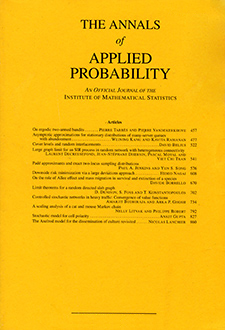Abstract
We introduce two new types of random field. The cross correlation field $R(\mathbf{s}, \mathbf{t})$ is the usual sample correlation coefficient for a set of pairs of Gaussian random fields, one sampled at point $s \epsilon \Re^M$, the other sampled at point $\mathbf{t} \epsilon \Re^N$. The homologous correlation field is defined as $R(\mathbf{t}) = R(\mathbf{t}, \mathbf{t})$, that is, the "diagonal" of the cross correlation field restricted to the same location $\mathbf{s} = \mathbf{t}$. Although the correlation coefficient can be transformed pointwise to a t-statistic, neither of the two correlation fields defined above can be transformed to a t-field, defined as a standard Gaussian field divided by the root mean square of i.i.d. standard Gaussian fields. For this reason, new results are derived for the geometry of the excursion set of these correlation fields that extend those of Adler. The results are used to detect functional connectivity (regions of high correlation) in three-dimensional positron emission tomography (PET) images of human brain activity.
Citation
Jin Cao. Keith Worsley. "The geometry of correlation fields with an application to functional connectivity of the brain." Ann. Appl. Probab. 9 (4) 1021 - 1057, November 1999. https://doi.org/10.1214/aoap/1029962864
Information





